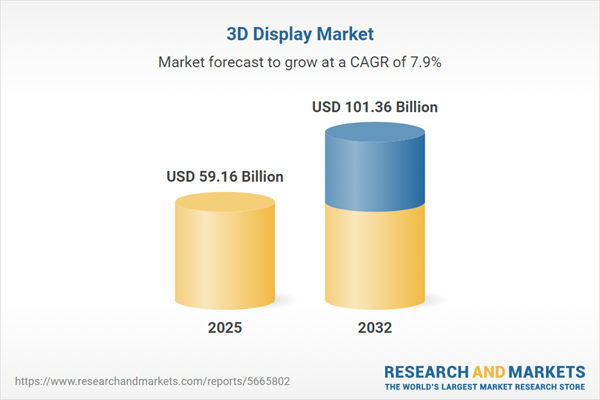Speak directly to the analyst to clarify any post sales queries you may have.
The three-dimensional display market is undergoing notable transformation, driven by technological advances and evolving applications across enterprise, industrial, and consumer environments. Senior decision-makers must stay informed to capitalize on fast-emerging opportunities in this space.
Market Snapshot: Growth Across Verticals in the 3D Display Market
The 3D display market grew from USD 55.13 billion in 2024 to USD 59.16 billion in 2025 and is projected to reach USD 101.36 billion by 2032, with a CAGR of 7.90%. Growth is fueled by adoption in entertainment, healthcare, automotive, and manufacturing, with increasing investment in next-generation rendering and immersive visualization. Widespread enterprise integration, expanding use cases, and changing policy landscapes are shaping global trajectories.
Scope & Segmentation: 3D Display Market Analysis
- Types: Holographic display, stereoscopic display, volumetric display
- Technologies: Digital light processing, LED, OLED, plasma display panel
- Components: Display panel, light engine, projection system
- Access Methods: Conventional/screen-based display, micro-display
- Applications: Head-mounted display, monitor, projectors, smartphones, TV
- End Users: Commercial, industrial, residential
- Regions: Americas (including North America and Latin America), Europe (United Kingdom, Germany, France, Russia, Italy, Spain, Netherlands, Sweden, Poland, Switzerland), Middle East (United Arab Emirates, Saudi Arabia, Qatar, Turkey, Israel), Africa (South Africa, Nigeria, Egypt, Kenya), Asia-Pacific (China, India, Japan, Australia, South Korea, Indonesia, Thailand, Malaysia, Singapore, Taiwan)
- Leading Companies: 3CINNO Group, 3D Global GmbH, 3D Systems, 3M Company, AUO Corporation, Autodesk, Barco NV, Christie Digital Systems, Continental AG, FUJIFILM Holdings, Himax Technologies, Japan Display, Koninklijke Philips, Leyard American, LG Electronics, Mitsubishi Electric, Panasonic Holdings, Samsung Electronics, SeeReal Technologies, SHARP, Sony, TCL Corporation, The Coretec Group, Toshiba, ViewSonic
Key Takeaways for Senior Decision-Makers
- Three-dimensional display technology is transitioning from entertainment-centric applications to include data analytics, remote collaboration, and industrial design, expanding addressable markets and enabling new revenue streams.
- Augmented and virtual reality are emerging as central drivers for 3D display adoption in sectors prioritizing interactive user experiences, simulation, and enterprise training.
- Innovations in micro-display modules and projection technology are reducing device size and energy requirements, supporting the growing adoption of wearables and portable 3D display systems.
- Integrated artificial intelligence capabilities in display engines are supporting adaptive rendering and improved image quality, optimizing performance for mission-critical applications.
- Adoption patterns vary regionally, with North America emphasizing R&D and partnership-driven innovation, Europe focusing on sustainability, and Asia-Pacific leading in high-volume manufacturing and government-sponsored deployments.
Tariff Impact: Navigating New Regulatory Headwinds
- Recent US tariffs on imported three-dimensional display components are affecting sourcing, manufacturing strategies, and pricing structures for global and domestic producers.
- Procurement and supply chain leaders are mitigating risks by dual-sourcing, nearshoring, and stockpiling high-value modules to maintain cost control and production continuity.
- Greater investment in localized manufacturing and collaborative ventures is enhancing supply chain resilience and long-term competitiveness for agile organizations.
Methodology & Data Sources
Research for this report utilized a blend of primary methods—executive interviews, product manager discussions, and end-user surveys—with secondary analysis of industry publications, patent filings, and proprietary supply chain data. Data triangulation ensured reliability, while scenario analysis supported examination of policy shifts, technology introductions, and market dynamics.
Why This Report Matters
- Enables executives to identify high-growth sectors and shape R&D priorities in a rapidly maturing 3D display market.
- Supports risk mitigation and investment decisions by detailing supply chain challenges and regional adoption variations.
- Provides actionable segmentation and competitor analysis for informed product, partnership, or geographic market strategies.
Conclusion
The three-dimensional display sector is at a critical juncture, with evolving technology and policy factors driving industry change. Strategic focus on innovation, supply chain agility, and targeted collaboration will be essential for sustained market leadership.
Additional Product Information:
- Purchase of this report includes 1 year online access with quarterly updates.
- This report can be updated on request. Please contact our Customer Experience team using the Ask a Question widget on our website.
Table of Contents
3. Executive Summary
4. Market Overview
7. Cumulative Impact of Artificial Intelligence 2025
Companies Mentioned
The companies profiled in this 3D Display market report include:- 3CINNO Group Co.,Ltd.
- 3D Global GmbH
- 3D Systems, Inc.
- 3M Company
- AUO Corporation
- Autodesk Inc.
- Barco NV
- Christie Digital Systems USA, Inc.
- Continental AG
- FUJIFILM Holdings Corporation
- Himax Technologies, Inc.
- Japan Display Inc.
- Koninklijke Philips N.V.
- Leyard American Corporation
- LG Electronics, Inc.
- Mitsubishi Electric Corporation
- Panasonic Holdings Corporation
- Samsung Electronics Co., Ltd.
- SeeReal Technologies S.A.
- SHARP CORPORATION
- Sony Corporation
- TCL Corporation
- The Coretec Group
- Toshiba Corporation
- ViewSonic Corporation
Table Information
| Report Attribute | Details |
|---|---|
| No. of Pages | 182 |
| Published | November 2025 |
| Forecast Period | 2025 - 2032 |
| Estimated Market Value ( USD | $ 59.16 Billion |
| Forecasted Market Value ( USD | $ 101.36 Billion |
| Compound Annual Growth Rate | 7.9% |
| Regions Covered | Global |
| No. of Companies Mentioned | 26 |









